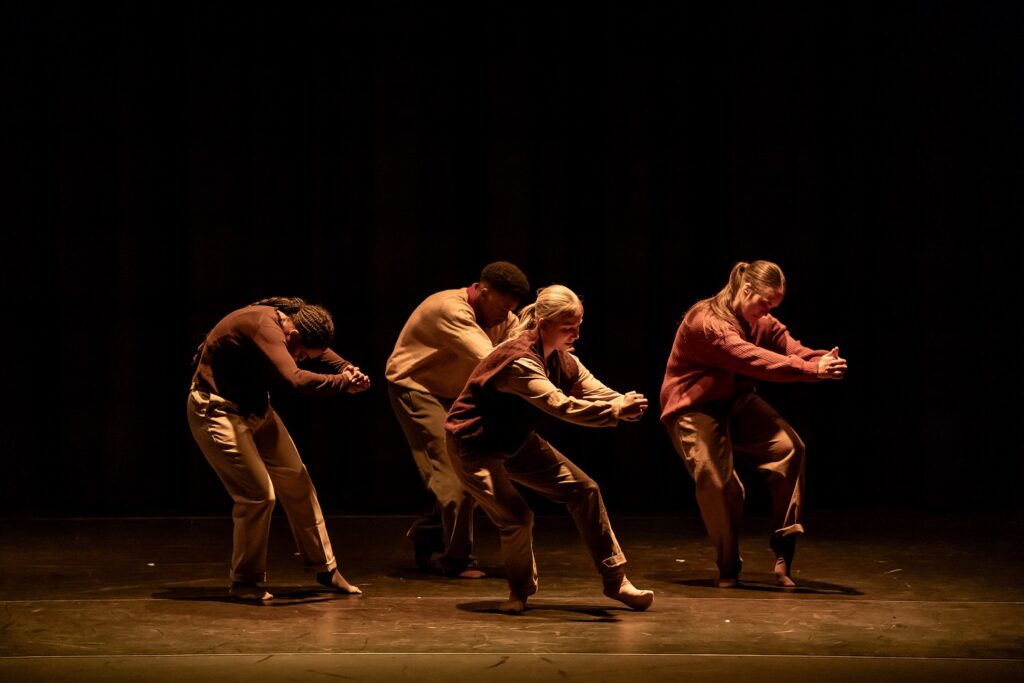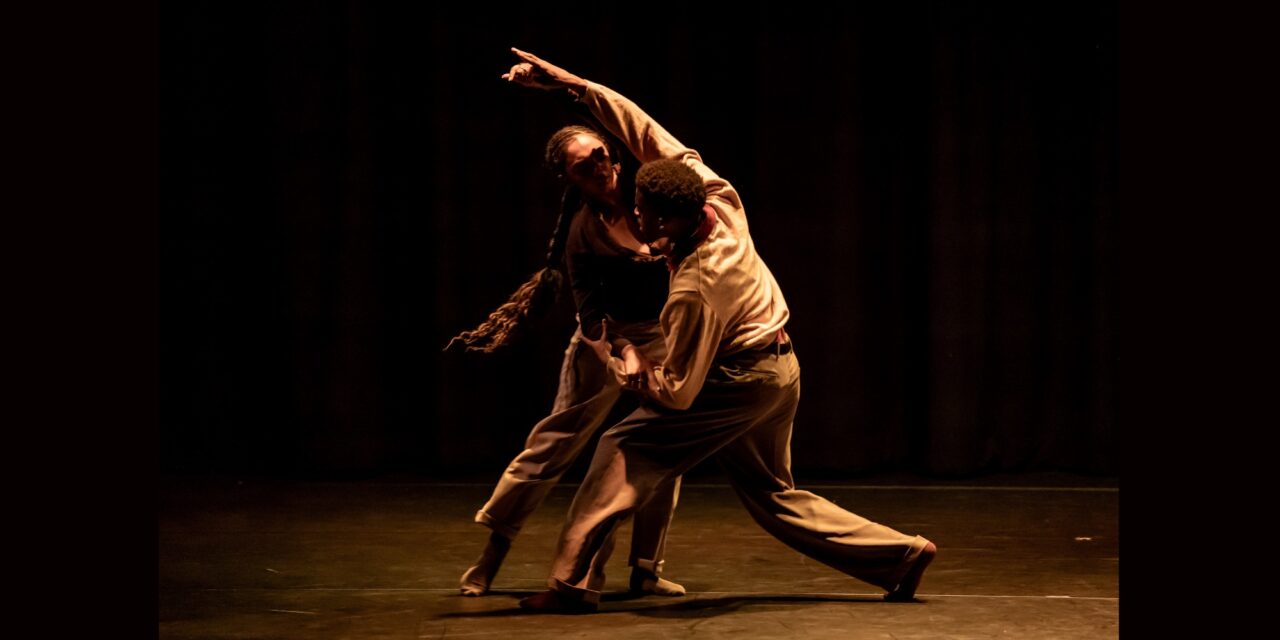Let’s get right to it: Sunday’s USC Alumni Residency show at the Glorya Kaufman Performing Arts Center at Vista del Mar warrants a significantly biased review, because I am an alumnus of the USC Kaufman School of Dance myself. Beyond my emotional investment in my friends’ dancing and choreographic careers, there is our shared education to consider. Our compositional and aesthetic preferences overlap, at the very least; not to mention my stake in the school’s reputation as a member of the first graduating class. What I can offer, though, is context on my classmates’ artistic trajectories, and an impression of the residency’s impact for emerging dancers and dancemakers.
The USC Alumni Residency was created in partnership between the school and the performing arts center, “designed to empower and foster creativity among talented alumni choreographers” by offering studio space, a stipend, and a stage for the creation of new works. Sara Silkin, the center’s artistic director, took care to acknowledge how the selected alumni pooled their resources to the evening’s benefit. All of the music on the program was written by composer and dancer Daniel Mangiaracino, a graduate student at USC’s Thornton School of Music, and most of the dancers (majority USC Kaufman alumni) appeared in multiple works.
Sunday’s bill featured works by Stephanie Dai, JA Collective (Jordan Johnson and Aidan Carberry), and Madison Falconer. The aforementioned aesthetic overlap and shared resources wove a compelling visual through line into the program, but the three pieces were satisfyingly diverse, each choreographer’s voice peeking through a composite canvas.

USC Alumni Residency – L-R Casey Murray, Justin Epstein in Stephanie Dai’s “not now, I’m noticing the pattern” – Photo by Cheryl Mann.
Stephanie Dai’s “not now, I’m noticing the pattern” opened with Seth Horinouchi and Davon Rashawn Farmer duetting a mountain-climbing saga. Dai is a witty dancer: her instincts are charming, sharp and incredibly specific. Her choreography nests another dimension of intention in every single count, layering dynamics, connotation, and the greater narrative arc. Horinouchi and Farmer communicated each layer deliberately, their focus so laser that you could follow it to the mountains beneath them, arctic wind blowing from Mangiaracino’s score. They were beautiful, serious, and dramatic.

USC Alumni Residency – L-R Davon Rashawn Farmer, Seth Horinouchi in Madison Falconer’s “CLAY-MADE” – Photo by Cheryl Mann.
But the best thing about Dai is that she will always surprise you. The second punch hits as you are still absorbing the complexity of the first. Post-duet, director Casey Murray walked onstage for his guest appearance on Justin Epstein’s talk show, slotted to discuss his new release — the climbing film we just watched, starring Horinouchi and Farmer. Imagine a choreographic play on Between Two Ferns, or The Eric Andre Show, and recalibrate accordingly. Dai orchestrated the interview with a delicate balance of cheese and cringe, Murray and Epstein playing with performativity, social conventions, process, and gesture to a delightfully absurd tone.

USC Alumni Residency – L-R Davon Rashawn Farmer, Seth Horinouchi in Madison Falconer’s “CLAY-MADE” – Photo by Cheryl Mann.
Horinouchi climbed over them as they spoke. Farmer scaled the back wall. Murray and Epstein were absolutely committed to their personality roles, their comedic timing priceless. They alternated occupying the straight role, constantly missing each other’s social cues. The audience gasped, laughed, and held their breath simultaneously. I have seen these artists — who I would call absolutely brilliant dancers — perform many technically virtuosic roles but was floored once more by their depth and charisma. The unexpected range between modes was so true to Dai, matching the thoughtful intricacy in the dramatic against her propensity for comedic timing. Whiplash has never felt so good.

USC Alumni Residency – Emma Sutherland in JA Collective’s “This is a piece called “Why My Dad Left the Light On. It Begins and Ends with a Light Turning On and Off a Few Times” – Photo by Cheryl Mann
JA Collective’s “This is a piece called “Why My Dad Left the Light On. It Begins and Ends with a Light Turning On and Off a Few Times” did, in fact, begin and end that way. As the light switched from the floor at downstage center, it caught fragments, stages of Murray, Farmer, and Emma Sutherland in motion. Farmer moved with unprecedented stretch to his timing and line. Murray, a beacon of levity in the last piece and now a steadfast anchor, was precisely on cue every time.

USC Alumni Residency – JA Collective’s “This is a piece called “Why My Dad Left the Light On. It Begins and Ends with a Light Turning On and Off a Few Times” – Photo by Cheryl Mann.
In this work, Sutherland stood out as absolutely effervescent. She carved through shapes with determined ease, reckless control. As her fingertips met Murray’s, the single light center stage began moving with them, wielded via pole by Carberry himself, dressed in all black. As they wove in and out of each other in JA’s signature style, Carberry synced astoundingly specific lighting cues with the music and choreography, changing angles in split seconds to direct the eye as though through a camera lens. JA has spent the last few years directing music videos, perfecting the camera transition and the long shot, but to see this technique employed on a stage was breathtaking and experiential for a viewer in a seat so far away. Carberry and his light became the fourth dancer, lending an otherworldly intimacy to the spotlight we know. It felt like seeing into the artists’ homes, witnessing pivotal points in their lives. In the final sequence, the excerpted movements we saw before were woven into phrases, lit from global angles that filled in the blanks of each sequence, washing us over with relief and finality.

USC Alumni Residency – L-R Kayla Goldsberry, Davon Rashawn Farmer, Madison Falconer, Emma Sutherland in Madison Falconer’s “CLAY-MADE” – Photo by Cheryl Mann.
Madison Falconer’s “CLAY-MADE” set dancers as sculpted figures across a tapestry of nostalgia. In a summer day at the creek, autumn leaves at dusk, she drew vignettes of life’s poignant moments with gentle care. Sutherland, Farmer, and Epstein returned to the stage, this time joined by Kayla Goldsberry and Falconer herself, all falling in and out of sync. The dancers became even more of themselves, Goldsberry steadying the energy with gorgeous, sure shapes and Falconer radiating light as she arranged the cast into sentimental scenes. Falconer has an uncanny ability to choreograph something that is both new and familiar, so that you see your loved ones in the dancers and their steps. She depicts our lives and loves in warm, understanding light, through seamlessly blended strings of movement that hold the peaks and valleys of a lifetime.
Carberry stepped in to light “CLAY-MADE” with the same effects he used on “…Light On…,” which just added an extra tinge of golden hour glow. I could not have guessed that the lightboard glitched and wiped Falconer’s lighting cues five minutes before show — she and Carberry actually blocked lighting backstage via video before he tried it for the first time during the performance. But it somehow tessellated into the mood effortlessly, pulling all the pieces back into a shared universe as the work concluded with dancers from all three pieces folded into one world, wandering the stage in counterpoint.
Though I know and will advocate for each of these artists personally, the evening surpassed even my expectations, really revealing what a little time and space can do for a group of young dancemakers. Because these USC Kaufman alums have all spent at least four years in similar orbits, they have the ability to function as a pseudo-company, a shorthand already developed, an understanding of each other’s artistic voices, an abundance of talent, and easy rapport. But what I felt here was the space and distance from their conservatory education that allowed each artist’s voice to begin differentiating, and the care and support of their community — including each other — to do so with confidence.
To learn more about the CSU Glorya Kaufman School of Dance, please visit their website.
For more information about the Glorya Kaufman Performing Arts Center, please visit their website.
Written by Celine Kiner for LA Dance Chronicle.
Featured image: USC Alumni Residency – JA Collective’s “This is a piece called “Why My Dad Left the Light On. It Begins and Ends with a Light Turning On and Off a Few Times” – Photo by Cheryl Mann.








